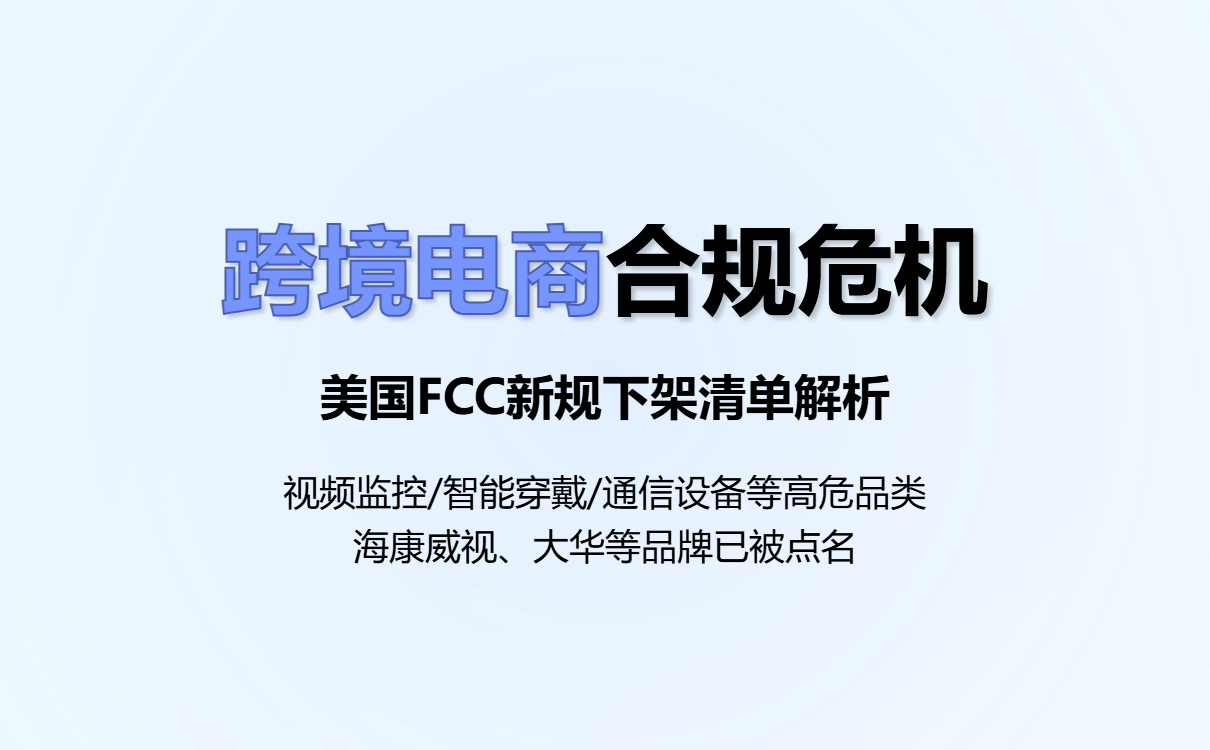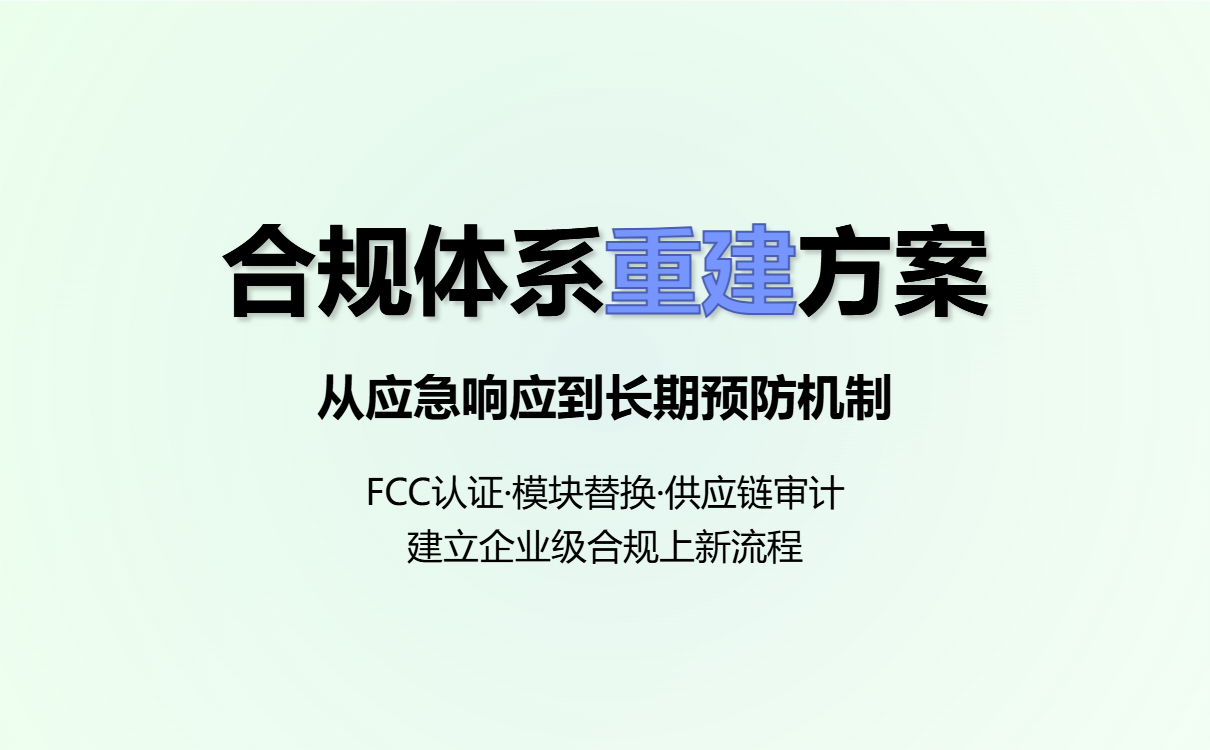
On October 10, 2025, the U.S. Federal Communications Commission (FCC) announced and declared that its "Operation Clean Carts" had achieved initial results, prompting major U.S. e-commerce platforms (such as Amazon, eBay, etc.) to remove "millions" of online product pages of electronic devices made in China that were identified as banned or unauthorized.
The products removed from shelves primarily involve wireless communications, video surveillance, and devices related to communications authorization. News reports and the FCC indicate that typical categories include: home/commercial video surveillance cameras (including webcams/NVRs), smartwatches and children's tracking watches, routers/wireless gateways, modules/devices that may access telecommunications networks, and some mobile phones and communications equipment. Several well-known manufacturers have been specifically named (or placed on the Covered List/Watchlist), including Huawei, ZTE, Hikvision, and Dahua.

Note: While different sources use different statistical calibers ("millions" refers to the number of product pages combined across platforms), the categories and brand/manufacturer concentration are highly consistent. Below are listed categories and examples with a high probability of being mentioned, or clearly mentioned in news reports.
1. Video surveillance and security
IP cameras, DVRs/NVRs, surveillance kits, Wi-Fi security cameras, doorbell cameras, and cloud recording service bundled devices.
Representative manufacturers/brands (mentioned or receiving attention in the news): Hangzhou Hikvision, Dahua.
2. Smart wearables with communication functions
Smart watches that support cellular/positioning/voice communications, children's positioning watches, bracelets with SIM cards, etc. (because they contain communication and positioning modules).
3. Communication/network access equipment
Routers, wireless routers, 4G/5G modules, mobile hotspots, and certain devices that can directly access operator networks (especially those from companies listed on the "Covered List").
4. Small appliances/IoT devices with wireless (RF) or two-way communication capabilities
Smart door locks, smart home gateways, intercom devices, etc. Because they contain wireless communication or can upload/download data.
Mobile phones and simple consumer electronics (if the manufacturer is on the banned list or does not have FCC authorization).
Child trackers and pet locators with GPS/Bluetooth/Wi-Fi (if using unauthorized RF modules).
USB cables and chargers only (if they do not have RF functionality) – these devices generally do not fall under the category of “Covered” communications devices restricted by the FCC for national security reasons, but still need to meet general electrical/safety standards and platform policies.
III. The main adverse impacts of this removal/action
Immediately terminate orders, cancel orders and refund them , and cause unsold inventory (traffic interruption caused by platform removal).
Cash flow pressure : External channels such as Alibaba and AliExpress may not be able to absorb these inventories in the short term.
It is necessary to complete/submit additional documents (RF testing, FCC authorization, proof of origin and compliance), pay third-party compliance consultants or testing fees (often several thousand to tens of thousands of US dollars per model).
Named manufacturers or stores that are frequently removed from the shelves will suffer damage to their reputation on the platform, and negative reviews and refund records will affect the store's weight and advertising/traffic distribution.
B2B buyers/overseas distributors may suspend purchases or request additional compliance certifications, leading to increased return rates and reduced trust in business relationships.
Small and medium-sized sellers may be forced to exit some US and European markets, increasing industry concentration. They may instead flock to alternative markets (Southeast Asia, Africa, and Latin America), leading to price wars and declining profits. News reports also suggest that US regulations will continue to intensify, potentially raising compliance thresholds in the future.

The following tasks are sorted by "Must do immediately / within 24-72 hours / within 1-4 weeks" for easy execution.
1. Suspend advertising for related products and halt new shipments to affected platforms' warehouses (especially FBA/platform warehouses) . Reason: To avoid increased refunds/returns and more severe platform penalties.
2. Set a "Compliance pending verification" temporary removal or unsaleable inventory mark on all platforms (stores) , and publish a unified customer service copy (a sample is provided below).
3. Export and back up all affected SKU listing data, transaction records, buyer information, shipping order numbers, country of origin and purchase invoices, technical specifications (user manuals/specs), and correspondence emails . These will be essential materials for subsequent appeals and/or supplementary evidence.
4. Designate a responsible person (or team) to be responsible for compliance response and assign a clear task list (such as: document collection/third-party testing/platform communication/return processing/external law firm liaison).
1. Verify whether each SKU involves radio frequency/communication/video/positioning functions (if so, it is considered high risk).
2. Verify whether the device uses chips or modules from the FCC Covered List (or entities designated as high-risk by the US) . (If such modules are used, compliance costs and difficulty are significantly higher.) Refer to FCC guidelines to confirm the Covered List and classify accordingly.
3. Submit an urgent compliance communication email to the platform (Amazon/eBay) (attach the purchase invoice, technical specifications, and existing test reports). Use the platform's compliance/policy complaint channel and retain the ticket number. A template is provided below.
4. Notify existing B2B customers/distributors (using transparent but cautious language to indicate that the issue is being addressed, with a promised timeline and alternatives) to reduce large-scale chargebacks and loss of trust.
1. Send high-risk SKUs to an accredited testing facility (RF/cybersecurity/privacy-related) as soon as possible for complete testing and obtain a report or list of non-compliance items . If the device is confirmed to be non-compliant, remove it from shelves and cease sales immediately.
Tip: Choosing an accredited laboratory (CNAS/ILAC accredited) or an FCC-accredited testing organization can increase your persuasiveness.
2. Evaluate whether it is possible to apply for or restore FCC authorization for the device (if the device meets technical/safety requirements) ; if not, plan product replacement (replace the RF module or use an authorized module).
3. Improve supply chain compliance clauses : Sign written compliance guarantees with upstream suppliers (including certificate copies, chip source declarations, and test record delivery obligations).
4. Establish a "re-listing prevention" process : Before adding a new SKU, a compliance checklist (function/RF/module source/authorization certificate/test report/supplier statement) must be completed. Any subsequent listing on the platform must first pass an internal compliance review.
Here we provide three types of feasible solutions: "low cost → medium cost → high cost", which enterprises can use according to their own resource combinations.
1. Temporary removal of product from shelves + customer service communication + return/refund processing plan (to reduce negative reputation).
2. Prioritize the allocation of affected inventory to non-affected markets (Southeast Asia, Africa, Latin America, Russia, etc.) or offline wholesale channels (pay attention to local compliance requirements).
3. Conduct direct sales on your own sites and social media to avoid platform restrictions (but pay attention to local regulations and payment/logistics compliance).
1. Entrust a domestic/international third-party compliance consulting firm to conduct a "compliance check" (compile a list of affected products and a list of required certificates).
2. Send the product to a certification laboratory for RF/Electromagnetic Compatibility (EMC) and cybersecurity testing, and obtain the corresponding report . If the test passes, you can use it to appeal to the platform to restore the listing.
3. Technical rectification : Replace the problematic RF module with an FCC-authorized module (module replacement can often significantly reduce certification costs).
Systematically obtain FCC equipment authorization for key product lines (including commissioning TCB testing and submitting for FCC certification) - suitable for models with long-term layout in the US market and clear profit.
Adjust product lines and R&D directions : develop "non-RF" or alternative products using compliant modules, or shift core business to software/service orientation to desensitize from high-risk hardware exposure.
Legal remedies : If you clearly believe that the platform or regulator has made a misjudgment, you can ask a lawyer to assess whether to file for administrative review or other legal remedies (which are costly and time-consuming).
English Simplified Version (Can be used for Seller Performance/Appeals)
Subject: URGENT — Compliance documentation for ASIN/SKU [your SKU] — Request for reinstatement
Dear [Platform] Compliance Team,
We are the seller of SKU [xxx]. Following recent enforcement actions, we proactively submitted the following documentation for your review: 1) Purchase invoice from supplier [name] dated [date]; 2) Technical specification sheet; 3) RF/EMC test report (or: testing in progress — expected completion [date]). We request temporary reinstatement under review or guidance on additional documents required. We are committed to full cooperation and can provide samples for independent testing. Please advise the next steps and the case/ticket number for tracking.
Best regards,
[Name, Company, Seller ID, Contact info]
(The same applies to the Chinese template. Please be sure to attach the purchase invoice, technical manual, existing test report or test order screenshot)
Purchase invoice (showing supplier/manufacturer/quantity/price/batch)
Product technical specifications (functional points, RF parameters, module models)
Product photos (including body nameplate, PCB module label, and outer packaging barcode)
Any existing test reports (RF/EMC/Safety/Cybersecurity) or test orders/purchase contracts (as evidence of an ongoing application)
Supplier Compliance Statement (the supplier's written commitment that the product does not infringe regulations or that they will cooperate in supplementing the certification)
Product serial number/batch shipment records and logistics documents (for easy traceability)
Prioritize: Immediately conduct self-inspections and remove high-risk SKUs; distribute inventory to non-US markets; contact upstream suppliers for returns or exchanges; utilize social media or build your own website to digest inventory.
Not recommended: Blindly looking for "grey certificates" or modifying product descriptions to try to bypass platform review (high risk, your store will be permanently closed).
Prioritize: sending samples for testing, replacing modules, and supplementing compliance certification; actively communicating with the platform and retaining evidence; establishing a compliant new product launch process.
What can be done: Evaluate and apply for FCC authorization for key SKUs.
Priority: Initiate compliance self-inspections for all product categories and supply chain audits (upstream module and chip sources), and develop long-term compliance strategies in parallel with law firms/consulting agencies.
What can be done: Public relations and customer communication strategies, hold special briefings for key customers, and strive for communication and support at the government/industry association level.

New Product Compliance Checklist (8 items that must be checked for new SKUs)
Whether it contains wireless/Bluetooth/Wi-Fi/GSM/4G/5G/LoRa, etc.; module model and authorization status; whether the test report is complete; supplier compliance statement; export license (if required); purchase invoice; product manual; legal compliance review signature before listing.
Supplier Compliance Clause Template (Add one to the contract)
Suppliers must provide complete certificates upon delivery and ensure legality and compliance in the target market, otherwise they will bear relevant responsibilities and compensation.
Internal inspection process : The compliance officer will randomly inspect 5% of the SKUs on sale every month and establish a "compliance archive."
Q: Can I put the product back on the shelf by changing its name or picture?
A: No. Platforms and regulators prioritize device functionality, radio frequency (RF)/module, and manufacturer background, which cannot be addressed with simple descriptions and images. Disguise or misleading information may result in more severe penalties.
Q: Is it possible to ship the inventory back to China and then transfer it to other platforms?
Answer: It is feasible in the short term, but you need to pay attention to the compliance requirements and transportation costs of the destination market, and maintain communication with the platform to reduce disputes.
10. Priority Action List (48 Hours/7 Days/30 Days)
Stop delivery, export affected SKU data, designate a responsible person, contact customer service and submit preliminary complaint materials, and publish unified customer service copy.
Complete the risk stratification of the affected SKUs, make a list of samples to be tested and place an order with the testing agency, and request a certificate of compliance/invoice from the supplier.
Decisions based on test results: Apply for FCC certification/replace modules/completely remove the product from shelves and iterate products; establish a long-term compliance system; communicate recovery plans with key customers.
For consumers (refunds/returns) :
Dear customer, hello!
Due to recent US regulatory and platform compliance reviews, we are conducting an urgent safety and compliance review of the model you purchased. To protect your rights, we will provide you with a refund or alternative plan as soon as possible. (If you prefer to wait, we will provide you with an update within 14 business days and prioritize your response.)
Thank you for your understanding and support.
—— Customer Service Team
For wholesalers/distributors :
Dear partners,
Due to recent tightening of US regulations, some models have been temporarily removed from US platforms. We have initiated a response process (including third-party testing and authorized module replacement). We expect to provide a clear restoration or replacement plan within 2–4 weeks.
If you need urgent supply, we can give priority to available models in other markets upon negotiation.
-- sales Manager
Compliance consulting companies/law firms : handle communications with governments/platforms, complaints, and legal risk assessments.
Third-party testing laboratory (RF/EMC/Network Security) : Issues authoritative test reports (CNAS/ILAC/or FCC-recognized lab).
Supply chain finance or inventory disposal service providers : Help quickly transfer/clear non-compliant inventory to the market or do B2B wholesale processing.
PR firm : Provides client communications and media handling advice when large-scale product removals cause brand damage.
This represents a structural increase in regulation and compliance , and similar actions and stricter standards are likely to occur in the future. In the short term, the focus should be on self-protection, compliance, and communication—protecting cash flow and customer trust. In the medium and long term, compliance capabilities should be considered a necessary cost of entering the European and American markets, and should be integrated into product design and supply chain management processes.
.png?x-oss-process=image/resize,h_100,m_lfit/format,webp)
.png?x-oss-process=image/resize,h_100,m_lfit/format,webp)

.png?x-oss-process=image/resize,h_100,m_lfit/format,webp)
.png?x-oss-process=image/resize,h_100,m_lfit/format,webp)
.png?x-oss-process=image/resize,h_100,m_lfit/format,webp)
.png?x-oss-process=image/resize,h_100,m_lfit/format,webp)
